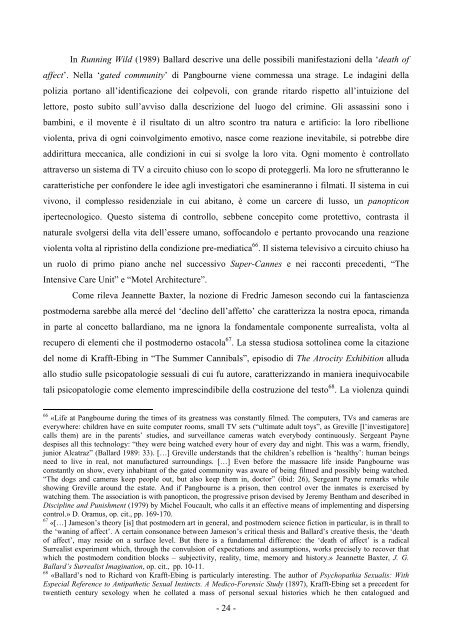The only truly alien planet is Earth. - UniCA Eprints - Università degli ...
The only truly alien planet is Earth. - UniCA Eprints - Università degli ...
The only truly alien planet is Earth. - UniCA Eprints - Università degli ...
You also want an ePaper? Increase the reach of your titles
YUMPU automatically turns print PDFs into web optimized ePapers that Google loves.
In Running Wild (1989) Ballard descrive una delle possibili manifestazioni della ‘death of<br />
affect’. Nella ‘gated community’ di Pangbourne viene commessa una strage. Le indagini della<br />
polizia portano all’identificazione dei colpevoli, con grande ritardo r<strong>is</strong>petto all’intuizione del<br />
lettore, posto subito sull’avv<strong>is</strong>o dalla descrizione del luogo del crimine. Gli assassini sono i<br />
bambini, e il movente è il r<strong>is</strong>ultato di un altro scontro tra natura e artificio: la loro ribellione<br />
violenta, priva di ogni coinvolgimento emotivo, nasce come reazione inevitabile, si potrebbe dire<br />
addirittura meccanica, alle condizioni in cui si svolge la loro vita. Ogni momento è controllato<br />
attraverso un s<strong>is</strong>tema di TV a circuito chiuso con lo scopo di proteggerli. Ma loro ne sfrutteranno le<br />
caratter<strong>is</strong>tiche per confondere le idee agli investigatori che esamineranno i filmati. Il s<strong>is</strong>tema in cui<br />
vivono, il complesso residenziale in cui abitano, è come un carcere di lusso, un panopticon<br />
ipertecnologico. Questo s<strong>is</strong>tema di controllo, sebbene concepito come protettivo, contrasta il<br />
naturale svolgersi della vita dell’essere umano, soffocandolo e pertanto provocando una reazione<br />
violenta volta al ripr<strong>is</strong>tino della condizione pre-mediatica 66 . Il s<strong>is</strong>tema telev<strong>is</strong>ivo a circuito chiuso ha<br />
un ruolo di primo piano anche nel successivo Super-Cannes e nei racconti precedenti, “<strong>The</strong><br />
Intensive Care Unit” e “Motel Architecture”.<br />
Come rileva Jeannette Baxter, la nozione di Fredric Jameson secondo cui la fantascienza<br />
postmoderna sarebbe alla mercé del ‘declino dell’affetto’ che caratterizza la nostra epoca, rimanda<br />
in parte al concetto ballardiano, ma ne ignora la fondamentale componente surreal<strong>is</strong>ta, volta al<br />
recupero di elementi che il postmoderno ostacola 67 . La stessa studiosa sottolinea come la citazione<br />
del nome di Krafft-Ebing in “<strong>The</strong> Summer Cannibals”, ep<strong>is</strong>odio di <strong>The</strong> Atrocity Exhibition alluda<br />
allo studio sulle psicopatologie sessuali di cui fu autore, caratterizzando in maniera inequivocabile<br />
tali psicopatologie come elemento imprescindibile della costruzione del testo 68 . La violenza quindi<br />
66 «Life at Pangbourne during the times of its greatness was constantly filmed. <strong>The</strong> computers, TVs and cameras are<br />
everywhere: children have en suite computer rooms, small TV sets (“ultimate adult toys”, as Greville [l’investigatore]<br />
calls them) are in the parents’ studies, and surveillance cameras watch everybody continuously. Sergeant Payne<br />
desp<strong>is</strong>es all th<strong>is</strong> technology: “they were being watched every hour of every day and night. Th<strong>is</strong> was a warm, friendly,<br />
junior Alcatraz” (Ballard 1989: 33). […] Greville understands that the children’s rebellion <strong>is</strong> ‘healthy’: human beings<br />
need to live in real, not manufactured surroundings. […] Even before the massacre life inside Pangbourne was<br />
constantly on show, every inhabitant of the gated community was aware of being filmed and possibly being watched.<br />
“<strong>The</strong> dogs and cameras keep people out, but also keep them in, doctor” (ibid: 26), Sergeant Payne remarks while<br />
showing Greville around the estate. And if Pangbourne <strong>is</strong> a pr<strong>is</strong>on, then control over the inmates <strong>is</strong> exerc<strong>is</strong>ed by<br />
watching them. <strong>The</strong> association <strong>is</strong> with panopticon, the progressive pr<strong>is</strong>on dev<strong>is</strong>ed by Jeremy Bentham and described in<br />
D<strong>is</strong>cipline and Pun<strong>is</strong>hment (1979) by Michel Foucault, who calls it an effective means of implementing and d<strong>is</strong>persing<br />
control.» D. Oramus, op. cit., pp. 169-170.<br />
67 «[…] Jameson’s theory [<strong>is</strong>] that postmodern art in general, and postmodern science fiction in particular, <strong>is</strong> in thrall to<br />
the ‘waning of affect’. A certain consonance between Jameson’s critical thes<strong>is</strong> and Ballard’s creative thes<strong>is</strong>, the ‘death<br />
of affect’, may reside on a surface level. But there <strong>is</strong> a fundamental difference: the ‘death of affect’ <strong>is</strong> a radical<br />
Surreal<strong>is</strong>t experiment which, through the convulsion of expectations and assumptions, works prec<strong>is</strong>ely to recover that<br />
which the postmodern condition blocks – subjectivity, reality, time, memory and h<strong>is</strong>tory.» Jeannette Baxter, J. G.<br />
Ballard’s Surreal<strong>is</strong>t Imagination, op. cit., pp. 10-11.<br />
68 «Ballard’s nod to Richard von Krafft-Ebing <strong>is</strong> particularly interesting. <strong>The</strong> author of Psychopathia Sexual<strong>is</strong>: With<br />
Especial Reference to Antipathetic Sexual Instincts. A Medico-Forensic Study (1897), Krafft-Ebing set a precedent for<br />
twentieth century sexology when he collated a mass of personal sexual h<strong>is</strong>tories which he then catalogued and<br />
- 24 -

















